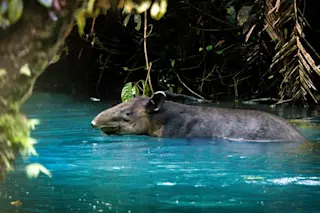Imagine an ancient mammal that looks like a blend of a pig and an anteater but is more closely related to horses and rhinos. This is the tapir, a fascinating creator that has roamed Earth for tens of millions of years.
With their strange prehensile snouts, sturdy bodies, and curious behaviors, tapirs have long intrigued scientists and nature enthusiasts alike. Here, we’ll explore what makes tapirs so unique, their habitats, their diets, and the critical conservation efforts needed to protect these endangered animals.
Brazilian tapir, also known as maned tapir (Credit: FotoRequest/Shutterstock)
FotoRequest/Shutterstock
A tapir is a large, herbivorous mammal belonging to the family Tapiridae. There are four living species of tapirs, each with a distinct habitat and appearance: Brazilian Tapir, Malayan Tapir, Baird's Tapir, and Mountain Tapir.
Tapirs have a distinctive prehensile snout — imagine a stubby elephant’s trunk — which they use to grab leaves and fruit. This ...














